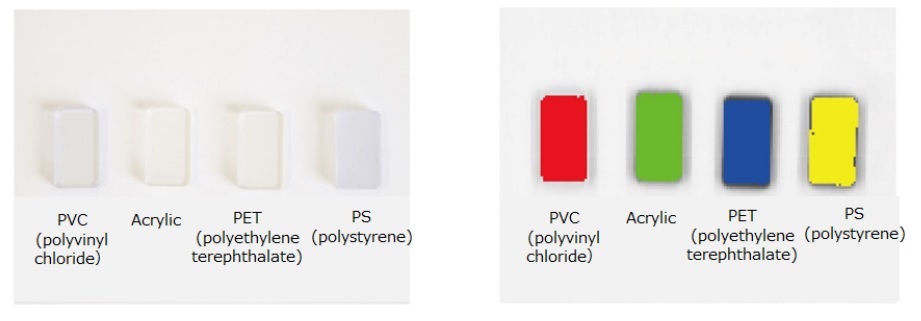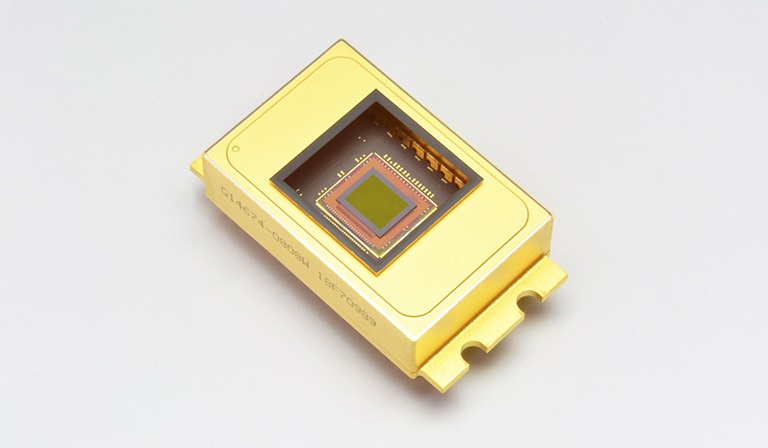2019/06/06
By applying compound opto-semiconductor manufacturing technology fostered in-house over many years, we designed and developed a new area image sensor G14674-0808W made of indium gallium arsenide (InGaAs) capable of detecting short-wavelength-infrared light up to 2.55 μm (micrometers or one millionth of a meter) which is the world’s longest wavelength detectable by this type of area image sensor. Installing this new InGaAs area image sensor into hyperspectral cameras for plastic recycling will boost the plastic recycling rate since hyperspectral cameras can screen and sort plastics containing flame-retardant resin to separate them out from other plastics, which has been extremely difficult up till now. Hamamatsu Photonics starts accepting product orders from domestic and overseas industrial camera manufacturers on July 1 (Monday), 2019.
Unlike ordinary cameras, hyperspectral cameras capture images by finely separating the light reflected from an object into a spectrum and obtaining the light intensity at each wavelength. Examining their spectral information in detail allows visualizing the differences between plastic materials and ingredients contained in food that are impossible to find with ordinary cameras. Hyperspectral cameras are currently in use for plastic recycling and food inspection applications.

Imaging examples of plastic materials captured with ordinary camera (left) and hyperspectral camera (right)
This product is an area image sensor designed for hyperspectral cameras. It consists of an InGaAs photosensitive area that converts light into electrical signals and a signal readout integrated circuit.
Currently, most hyperspectral cameras intended for plastic recycling applications use an InGaAs area image sensor that detects short-wavelength-infrared light up to 1.7 µm. But it can be nearly impossible for these cameras to sort out plastics containing flame-retardant resin from other general plastics. This has created demand for area image sensors that detect short-wavelength-infrared light up to 2.5 µm which is a wavelength well absorbed by flame-retardant resin.
Hamamatsu Photonics has developed and produced a wide variety of InGaAs area image sensors optimized for industrial applications including currently available devices with a large number of pixels able to detect short-wavelength-infrared light up to1.7 µm. To also enhance the productivity of compound opto-semiconductors and supply them to the market more effectively, we started up operation of Building No. 3 at our Miyakoda Factory site last year. This time, by utilizing equipment newly installed in the Miyakoda Factory Building No. 3, we were able to optimize the InAs and GaAs composition ratio and fully reviewed the manufacturing process for the photosensitive area. This work successfully reduced defects in the manufacturing process that have been serious issues up to now and led to developing an InGaAs area image sensor capable of detecting short-wavelength-infrared light up to 2.55 µm which is the world’s longest wavelength detectable by this type of area image sensor. We also designed and produced totally in-house a circuit optimized for the new InGaAs area image sensor that minimizes the dark current(*) generated in the photosensitive area and boosts the signal readout speed.
Installing this new InGaAs area image sensor into hyperspectral cameras allows capturing sharp images of plastics containing flame-retardant resin widely used in home appliances to sort them out from general plastics at high speeds. These properly screened and sorted plastics are used to produce high-purity recyclable materials and increase the plastic recycling rate, leading to reductions in the amount of non-recycled plastics that ultimately end up as useless waste in landfills. Hyperspectral cameras are also promising tools for diagnosing deterioration in concrete structures and for identifying tablet pharmaceuticals. To cover a wide range of applications, we will at the same time start accepting product orders for other InGaAs area image sensors with different spectral response ranges. We will also start accepting product orders for detection heads from October 2019 for easy evaluation of our InGaAs area image sensor performance characteristics.
Hamamatsu Photonics will continue to design and improve the photosensitive area to deliver area image sensors capable of detecting infrared light at even longer wavelengths. * Dark current: Electric current generated in a dark state with no light incident on the image sensor. Dark current causes unwanted image noise.















